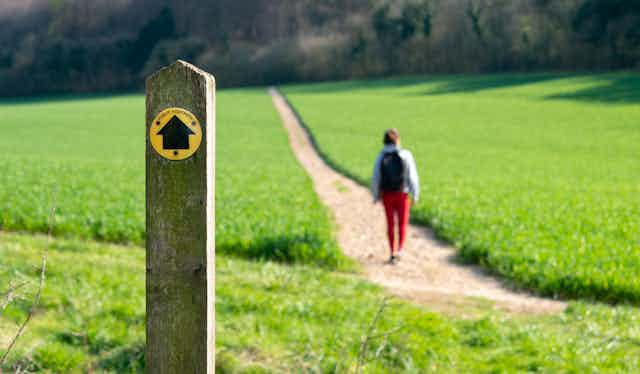Public rights of way are legally protected footpaths which let anyone pass over private land so that they can access the countryside for leisure and recreation. Each path is recorded and maintained by local authorities to ensure they remain open, unobstructed and free for all to use. But not all paths are afforded these protections – and if they are not correctly recorded, the public may be prevented from using them at any time.
Groups campaigning for greater public access to the countryside have been trying to find and register these paths so they can be used in perpetuity. These efforts took off in 2000 with the Countryside and Rights of Way Act (CROW), which set a 2026 deadline beyond which pre-1949 evidence of paths would no longer be accepted as proof of a public right of way. Any paths which were not officially recorded after this deadline would be lost to the public.
It looked like the government would scrap the deadline to register historic paths in England until recently, when the cut-off date was changed to January 1 2031 instead. While welcome news to landowners resistant to rights of way being claimed across their land, access campaigners such as the Ramblers and Open Spaces Society have criticised the government for backing out of a promise to abolish the deadline completely.
Given how long it has taken to record these paths so far, the public is almost certain to lose many existing rights of way once the deadline arrives.
Demystifying the ‘definitive’ map
All public rights of way in England and Wales are recorded in the definitive map and statement, which is the legal record maintained by local authorities. The original 2026 deadline gave the public 25 years to check that it was up to date in England, and, if it wasn’t, find the necessary evidence to add any missing paths.

Definitive maps were first introduced in 1949 as part of a post-war planning boom. Everything, it seemed, could be quantified, mapped out and determined by “the man in Whitehall”. Despite the optimism of Clement Attlee’s Labour government, the task has proven to be complex and interminable for local authorities.
My own research has revealed that determining the status of public rights of way takes a huge amount of work, particularly if there are disagreements and historic maps must be consulted and local memories interrogated. It took until May 1982 for the initial survey of counties to be completed, a total of 33 years – over three and a half times the average tenure of a local government employee.
Subsequent legislation streamlined the process, but a backlog of applications has been steadily building, leaving many local authorities with years or decades of delays, and increasingly limited budgets to address it.
The situation has got so bad that it recently emerged that people in Gloucestershire are dying before their applications are being heard. The scale of the problem is difficult to assess, but the Ramblers’ Don’t Lose Your Way campaign has found over 49,000 miles of rights of way that could be lost if they are not added to the definitive map.
The path ahead
The government’s initial decision to abolish the 2026 deadline in February 2022 was surprising, given previous legislation which sought compromises between landowners and campaigners. It spoke perhaps to an exasperation with the existing system, an admission that it might be better to let it run its course, as well as some post-Brexit enthusiasm for a new, popular, and environmentally friendly settlement on the land.

The reintroduction of the deadline is perhaps a reversion to type for the governing Conservatives, and has of course been welcomed by landowners: the Country Land and Business Association is reported to have lobbied assiduously for a 2031 deadline. While this feels like a loss for access campaigners, the five-year extension to the original 2026 deadline would appear to strike a compromise, at least from the government’s point of view.
The government has cited COVID-19 as justification for the five-year delay, but the problem is more deep-rooted. Public rights of way are a contentious issue that expose deeper concerns around who has the right to enjoy the land, and how to properly care for it given the parlous state of wildlife and habitats under Britain’s overwhelmingly private land ownership system. They are hard to deal with – and even harder to resolve. That alone explains the constant zigzagging of government promises and deadlines.
The government’s repeated U-turns illustrate the broader difficulties faced in England today. Is the time ripe for new and more expansive legislation? Labour certainly thinks so – but before it can implement any new settlement, the party will have to win a general election.

Don’t have time to read about climate change as much as you’d like?
Get a weekly roundup in your inbox instead. Every Wednesday, The Conversation’s environment editor writes Imagine, a short email that goes a little deeper into just one climate issue. Join the 10,000+ readers who’ve subscribed so far.

